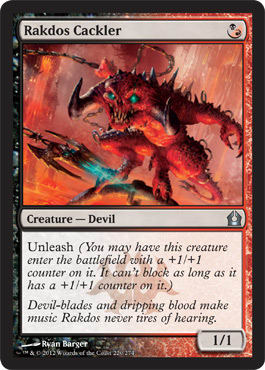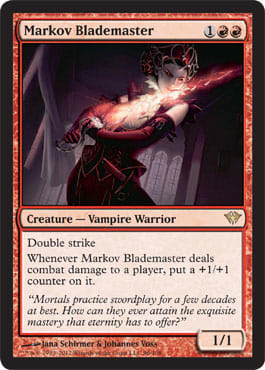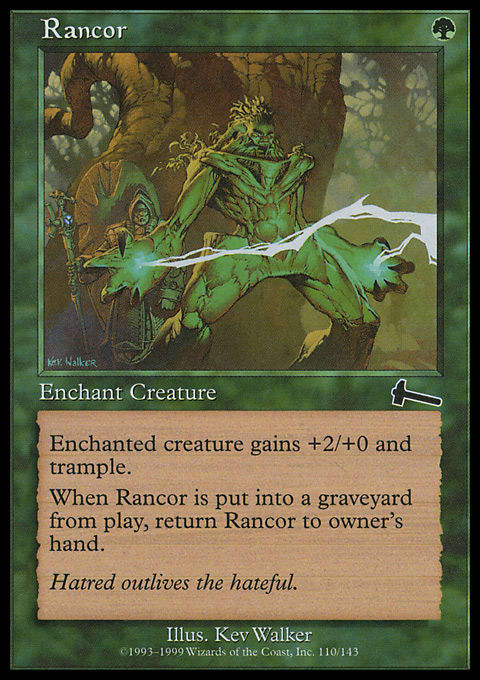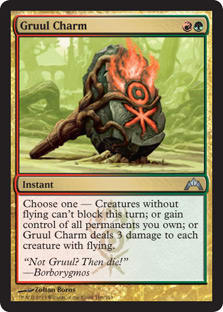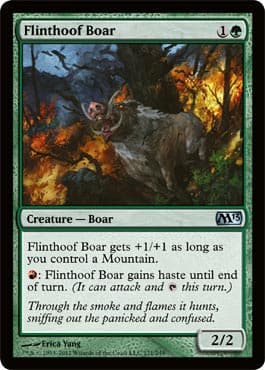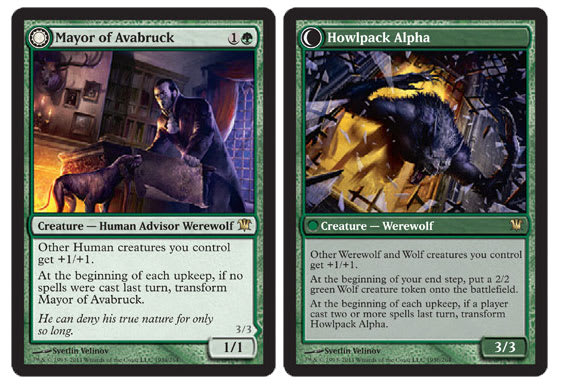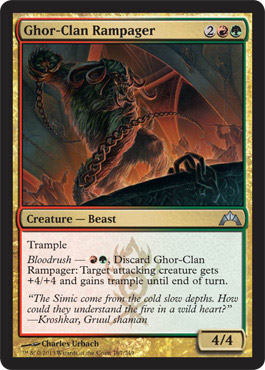Last month, I presented a Gruul aggro deck for your consideration, using a few of the cards from Gatecrash that had been revealed at that time. I've been working with the deck since then, and I think it could be solid enough to take down many of the top decks, even built on a budget. The deck has a lot of speed, and it can deal with cards such as Thragtusk and Restoration Angel much more easily than most aggressive decks can. Here's the latest version:
"Bloodstrike"
- Creatures (27)
- 3 Gore-House Chainwalker
- 4 Flinthoof Boar
- 4 Ghor-Clan Rampager
- 4 Hound of Griselbrand
- 4 Markov Blademaster
- 4 Rakdos Cackler
- 4 Stromkirk Noble
- Spells (11)
- 4 Searing Spear
- 3 Pillar of Flame
- 4 Rancor
- Lands (22)
- 11 Mountain
- 6 Forest
- 1 Kessig Wolf Run
- 4 Gruul Guildgate
- Sideboard (15)
- 3 Tormod's Crypt
- 3 Thunderbolt
- 3 Gruul Charm
- 3 Traitorous Blood
- 3 Skullcrack
The Threats
Rakdos Cackler is just as awesome as it appears to be. Having such easy access to a 2/2 for 1 brings back memories of Goblin Guide, and even without haste, the Cackler can lay down a serious beating on your opponent. It will usually get in 2 to 4 damage before trading off with a creature. Even if your opponent plays a blocker big enough to stop it, the Cackler will wait patiently until you build up a big enough force to justify an all-out attack, helping you deal some extra damage.
Despite the fact that it's a rare, Stromkirk Noble is often worse than Rakdos Cackler. Although the difference in the early turns is small—and on occasion, the Noble will even surpass the little Devil—once you hit about turn three, drawing a Stromkirk Noble is much, much worse than drawing Rakdos Cackler. The initial 1/1 body dies to just about everything, and it rarely trades with an opposing creature. A turn-one Deathrite Shaman is particularly annoying, thanks to that extra point of toughness. Despite these limitations, I feel Stromkirk Noble remains the best option for that second 1-drop slot. With more dual lands like Stomping Ground, Experiment One might be an option, but with the deck's mana base necessarily skewed heavily toward red, I hesitate to include a green 1-drop. The one way the Noble really does shine is in that it can't be blocked by Humans. The tribe is becoming increasingly popular as of late, making the Noble a dangerous threat.
Flinthoof Boar might be the best card in this deck. Call of the Conclave and Dreg Mangler are both great cards for aggro decks, and Flinthoof Boar is like having a split card with one on each side. You can throw it down on turn two and get ready to start the beating, or if you already have a 2-drop, you can cast it on turn three and attack for 6 right away. This is one card you definitely want to draw in multiples, since turn-two Flinthoof Boar into turn-three Flinthoof Boar is one of the best openings you can have.
Gore-House Chainwalker is a bit of a bore compared to the Boar, but with 3 power for 2 mana, it does the job. It's unfortunate that it can be killed by 2/2 creatures such as Borderland Ranger or a Wolf token, but you often have enough removal to clear the way for a turn or two, letting it deal a solid chunk of damage.
Markov Blademaster is a new addition to the deck, and it has been absolutely spectacular. With eight ways to make it big and tramply and seven ways to remove blockers, you'll almost always be able to get in that first hit. Dealing 3 damage with your 3-drop is nothing spectacular, but once you've done that, Markov Blademaster turns into an incredibly lethal threat. Just one more hit will deal 7 damage, meaning you've taken away half your opponent's life total with your 3-drop in just two attacks. More often, your opponent will be throwing creatures in front of it to try to stop the bleeding. If you have a Rancor, however, this is even more of a losing proposition, and your opponent is just dead unless he can kill it immediately.
Hound of Griselbrand was a solid creature in the previous version of the deck, but it becomes even more deadly now that we have Ghor-Clan Rampager to work with. There are times when your opponent, confident that he has dealt with your initial assault, will attack all-out into your board of just a single Hound. That's when you trade of the Hound with some creature, take some damage, and then hit it with bloodrush on the return strike for a whopping 14 damage.
The Support
Rancor is a great card in this deck—so great, in fact, that you have to be very careful about when you use it. Watching out for instant-speed removal is a given, but there is also a danger in casting it even when your opponent is tapped out. Putting a Rancor on your Rakdos Cackler is cool and makes for a lot of damage very quickly, but if your opponent doesn't kill it, you might not be able to get your Markov Blademaster in for damage later on. Weighing these possible lines of play is where your skill as a player can really make or break this deck.
Ghor-Clan Rampager may seem to belong in the threat section. After all, it is a creature, right? Wrong. I have played quite a few games with this deck, and I have never cast Ghor-Clan Rampager. Using the bloodrush ability, however, has been the final play in a staggering number of those games, often allowing me to kill my opponent two turns before he expected me to be able to. Although having the creature option is nice against control decks, against which you might have nothing left to give +4/+4 to, the Colossal Might mode is by far the most useful here. Such a large boost, combined with trample, makes this often a huge blowout against an overconfident opponent. When someone flashes in a Restoration Angel to block your Markov Blademaster, Ghor-Clan Rampager turns the situation from, “Oh, I guess my guy dies,” to, “Your Angel dies, you take 7, and my guy gets two +1/+1 counters.” Seems pretty good to me.
Searing Spear and Pillar of Flame clear the way for your Vampires, allowing you to acquire enough +1/+1 counters to make them real threats. They also deal with troubling creatures such as Huntmaster of the Fells, and they can be used to deal those last few points of damage to a stubbornly surviving opponent.
The Sideboard
Although the decklist is not particularly flexible, in matchups where Pillar of Flame is less than stellar, it can be swapped out for a more effective tool.
Tormod's Crypt fights any graveyard-based decks that might show up. Although these have been waning in popularity, I wouldn't count them out just yet, and you're not sacrificing much in order to be prepared for them.
Gruul Charm, although hailed as the worst of the cycle, is fairly effective for fighting token decks. With their swarms of creatures, pinpoint removal isn't very effective. The Charm gives you two relevant options. If Spirits from Lingering Souls and Midnight Haunting are cluttering up the battlefield, 3 damage to each flying creature should erase that problem. If the ground is clogged with Beasts and Wolves, the Falter option will allow you to ignore all of them for a turn and swing in for what is possibly lethal damage. Although you can't deal with both flying and non-flying tokens at once, the flexibility to remove either makes this quite useful.
Thunderbolt gives you another way to murder Restoration Angels at instant speed. The Angel is one of the favorite tools of midrange decks to shut down an aggressive assault, since its 4 toughness and flash make it difficult to deal with. With Thunderbolt, you can get rid of the Angel before it blocks and kills one of your attackers, helping you continue to push through damage.
Skullcrack stops Sphinx's Revelation from prolonging games indefinitely. Although Thragtusk alone is rarely difficult to overcome, a Sphinx's Revelation gives the control player not only time, but also resources. Skullcrack can steal back that time, leaving your opponent stuck with resources he'll never have the chance to use.
Traitorous Blood is useful for closing out games against larger threats such as Angel of Serenity. It usually functions as a Lava Axe or better for 3 mana, which is frequently enough to end the game.
Playtesting
Game 1
I won the roll and kept a hand of Gruul Guildgate, Forest, Rakdos Cackler, Stromkirk Noble, Flinthoof Boar, Hound of Griselbrand, and Ghor-Clan Rampager. I played the Guildgate and passed the turn. My opponent played a Cavern of Souls, naming Human, and cast Avacyn's Pilgrim.
I drew a Flinthoof Boar, played a Forest, and cast Stromkirk Noble before passing the turn. My opponent played a Plains, cast Silverblade Paladin, choosing not to pair it, and ended his turn.
I drew Searing Spear and attacked with Stromkirk Noble, dealing 1 and putting a counter on it. I passed the turn. My opponent played a Forest and cast Mayor of Avabruck, pairing it with the Paladin. He cast a second Mayor, and I killed the Paladin with Searing Spear in response. He passed the turn.
I drew another Spear and attacked for 2 with the Noble, putting a counter on it. I cast Flinthoof Boar and passed the turn. My opponent cast Frontline Medic and ended his turn.
I drew a Mountain, played it, and attacked with both creatures. My opponent blocked my Flinthoof Boar with his 5/5 Frontline Medic, and I bloodrushed my Ghor-Clan Rampager on the Boar. The Medic died, my opponent dropped to 12, and I put another counter on the Noble. I used my last mana to cast Rakdos Cackler and passed the turn. My opponent played Clifftop Retreat, cast Thalia, Guardian of Thraben and Avacyn's Pilgrim, and attacked with the first Pilgrim. I took 3, and he passed the turn.
I drew Rakdos Cackler and killed Thalia with a Searing Spear before attacking with Stromkirk Noble and Flinthoof Boar. The Boar traded with a Pilgrim, and my opponent dropped to 8. I put another counter on my Vampire and ended my turn. My opponent cast Champion of the Parish and passed the turn.
I drew Flinthoof Boar, cast it, and gave it haste. I attacked with the Noble and the Boar, the latter of which once again traded for a Pilgrim. My opponent took 5, and Stromkirk Noble grew to 6/6 before I ended my turn. My opponent passed the turn with no play, transforming his Mayors.
I drew Hound of Griselbrand, played another Flinthoof Boar, and gave it haste. I attacked once again with a Boar and the Noble, and my opponent was forced to block the Vampire with a Mayor as well as chump-block Flinthoof Boar with Champion of the Parish. I cast a Rakdos Cackler and passed the turn. My opponent cast Nearheath Pilgrim and passed the turn, making a Wolf token and pairing it up.
I drew a Mountain and attacked with everything. The token blocked Stromkirk Noble, the Mayor blocked a Rakdos Cackler, and my opponent dropped to 1 life. I cast Hound of Griselbrand and passed the turn. My opponent cast Champion of the Parish, then ended his turn, making another Wolf and pairing it with the Pilgrim.
I drew a land and attacked with everything save a Rakdos Cackler, and my opponent blocked the Noble with the Wolf token and the Hound with Champion of the Parish, staying at 1 life. I cast my second hound and passed the turn. My opponent drew his card and conceded.
Game 2
I kept a hand of Gruul Guildgate, Mountain, Forest, Rakdos Cackler, Markov Blademaster, and two Ghor-Clan Rampagers. My opponent started off by paying 2 life for a Temple Garden and casting Champion of the Parish. I drew a Forest, played my Mountain, and cast the Cackler.
My opponent played a tapped Stomping Ground, cast Avacyn's Pilgrim, and attacked for 2. I drew a Mountain, played my Guildgate, and swung back.
He played another Stomping Ground and attacked for 3. I drew Rancor, swung in for 2, then played a land and cast Markov Blademaster.
He played Kessig Wolf Run and passed the turn, and I drew a Forest, played it, and attacked with both creatures. The Champion blocked Markov Blademaster and the Pilgrim blocked the Cackler, earning an extra power from Kessig Wolf Run. Two Ghor-Clan Rampagers made Markov Blademaster a 9/9, however, and that ended the game on the spot.
Wrap-Up
I think this deck could be a serious player in the new Standard format. It can be frighteningly fast, and it doesn't roll over and die to large blockers. In addition, double strike combined with bloodrush is just fun. If you're looking for a fun aggro deck for Gatecrash Standard, give this one a try.
As always, if you have any questions or comments, you can find me on the forums under Twinblaze, on Twitter under @MTGCannon, or simply leave a comment below.













